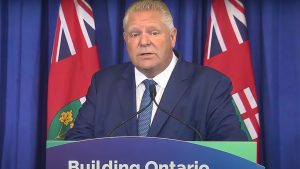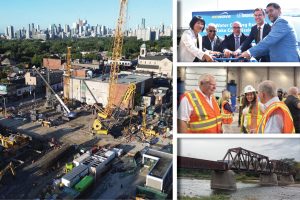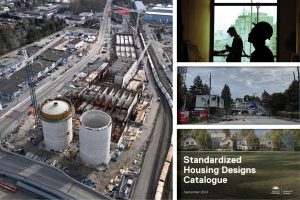ConstructConnect chief economist Alex Carrick hosted the third and final day of the CanaData 2020 economic forecasting conference, held virtually for the first time and featuring Export Development Canada vice-president and chief economist Peter Hall, Pinsent Masons LLP global business consultant Graham Robinson and Bank of America metals and mining equity research analyst Timna Tanners.
Hall began the sessions with a look at the changes the Canadian economy has undergone since the beginning of the COVID-19 pandemic in early March. “No living economist has seen this level of change. The pace of collapse and speed of our response really has no peer,” he said.
Below are some of the key points of his session:
- When we see a general rise in infection rates, that means the economy is going to slow, whether in total as seen in March and April, and partially now as we see a second wave of COVID-19 infections.
- What’s useful about this is that knowing this allows you to shield yourself from doing projects that might be compromised by a full or partial shutdown.
- We are telegraphing into our forecasts that the infection rates will be well contained.
- Retail sales was a “V” curve of two sharp down months and two up months.
- There was large pent up demand at the end of the downturn.
- There’s been a significant increase in bank balances during the pandemic and that represents billons that will eventually spill into the economy.
- It’s not just about just consumers, there’s a V shaped recovery in international trade as well.
- Not everything is V shaped in the economy: services have displayed an “L” shaped curve.
- People can’t move between borders and it’s been a zero year for tourism and the aerospace industry.
- Confidence for Canadian businesses has rebounded, but consumer confidence lags behind.
- Financial markets have largely recovered or surpassed pre-COVID levels.
- Interest rates are as low as they’ve ever been so if you need to accrue debt you can.
- Rule of thumb: harder you fall in 2020 the greater the rebound in 2021.
Robinson looked at the state of the global economy and the different levels of recovery going on across the globe. He said construction activity is what will lead the recovery out of the pandemic.
- Construction is a more practical industry for social distancing, and demand is much less influenced by consumer spending, tourism and there’s been a pent-up demand during lockdown.
- Construction is also investment driven, it’s leading instead of lagging.
- China recovered earliest and strongest, but the U.S. is also having a strong upturn.
- Middle East and North Africa are emerging as important centres of growth.
- Asia will increase its global share significantly at the expense of the developed world.
- Demographic trends also favour the Middle East and Asia.
- The “Anglosphere” countries will benefit the most from migration.
- Urbanization is steadily increasing, even in the developed world and the middle class continues to expand, especially in Asia.
- Quality of existing infrastructure is a key pillar of competitiveness.
- The top construction markets are China, the U.S., Japan, India, the U.K. Canada is at the lower end of the top 10.
- India is poised to take over from Japan as the world’s third largest construction market.
- The highest growth is in emerging Asia and sub-Saharan Africa.
- China is pulling back and that is what’s lowered economic recovery in the developed nations of Asia Pacific.
Tanners looked at commodities, forecasting for steel, copper, lumber and oil and gas.
- Steel is in plentiful supply and that will keep a lid on price forecasts.
- Copper demand is rising in China and there’s growing demand for copper globally.
- Electric vehicles could push copper demand.
- Lumber prices have been affected by a squeeze in supply and they may recover.
- Natural gas and oil have dipped and are expected to recover.
- The worst case of a prolonged downturn has not borne out, it’s been very V shaped.
- Cement and aggregates depend on construction markets 100 per cent and housing demand has been supportive and non-residential is steady for now.
- She doesn’t see much interest near term from the U.S. Congress for infrastructure, it will be focused on stimulus spending in response to the pandemic.
- Change of U.S. administration could see more steel being imported and greater pressure on U.S. prices.
- Steel production has been hampered by fewer people onsite due to COVID-19.
- COVID-19 crushed demand for oil and its derivatives. Low oil prices will constrain non-OPEC supply leading to a dramatic slowdown in shale output.
- “Steelmageddon.” Brace for a wall of sheet supply. It’s much more than can be absorbed easily and we see a real risk of price wars over next several years.
Carrick finished the day’s sessions with some of his own analysis of the Canadian economy.
- Canada is holding its own economically compared to the U.S.
- Canada’s clawback: Canada lost three million jobs but has since recovered two million jobs.
- Lowest provincial clawback ratios are Ontario and Alberta.
- The U.S. is doing better in terms of the stock market because the head offices of technology companies are in the U.S.
- The only company that seems reasonable is Amazon.
- Canada’s key export areas are Alberta energy products and Ontario motor vehicles and parts. Both if those products are down by a third.
- Canada is at +2.7 retail sales per year compared to +2.5 per year in the U.S.
- There hasn’t been a big drop in demand for housing in Canada.
- Toronto, Vancouver, Montreal multi-starts for housing are 60 per cent of all multi-starts in Canada.
- Roadwork: if Canada takes action on infrastructure, roads are an obvious place to start.
- De-globalization: Canada and the U.S. already work together and U.S. companies have Canadian subsidiaries so de-globalization might actually work to our advantage.
- The economic recovery will be uneven and there’s no way to escape that. What we don’t know: who will be next U.S. president, when will a vaccine arrive, how will working from home affect commuting traffic? How aggressive will rating agencies be in downgrading government debt?
If you’d like to read about the other CanaData 2020 sessions, we have a summary of both the demographics and technology sessions. Daily Commercial News staff writer Don Wall will also have a comprehensive story of all the speakers from Day Three in an upcoming article.











Recent Comments
comments for this post are closed